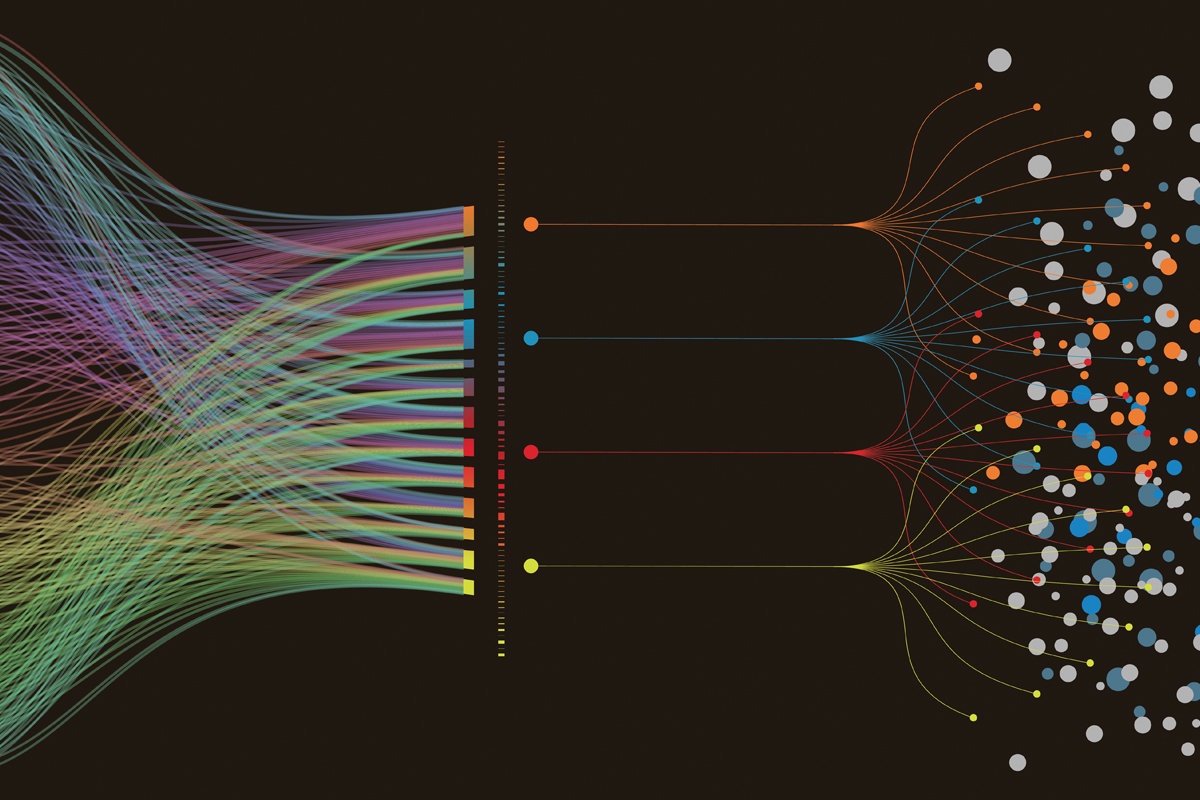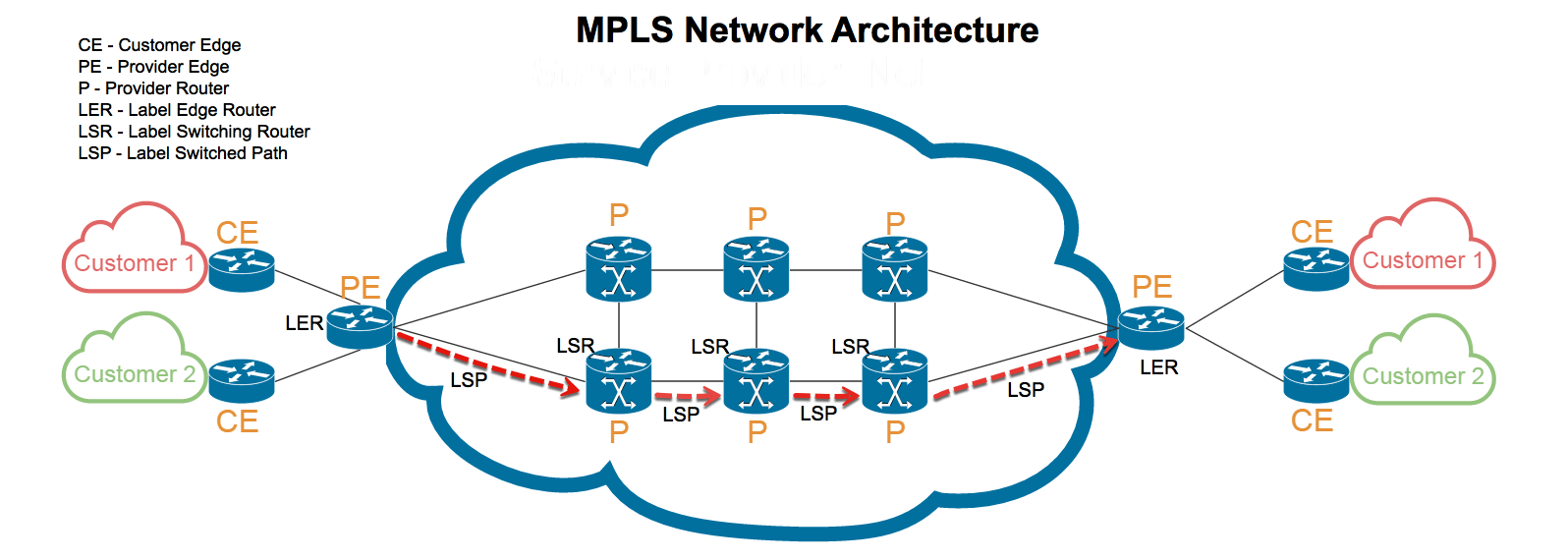Multiprotocol Label Switching (MPLS)
Multiprotocol Label Switching (MPLS)

Multiprotocol Label Switching (MPLS) is a routing technique in telecommunications networks that directs data from one node to the next based on short path labels rather than long network addresses, thus avoiding complex lookups in a routing table and speeding traffic flows.
The primary goal of the MPLS working group is to standardize a base technology that integrates the label swapping forwarding paradigm with network layer routing. This base technology (label swapping) is expected to improve the price/performance of network layer routing, improve the scalability of the network layer, and provide greater flexibility in the delivery of (new) routing services (by allowing new routing services to be added without a change to the forwarding paradigm).
MPLS Features and benefits:
Fully Meshed:
Multi Protocol Label Switching is a Fully Meshed, any to any network; when a new site is added, it can communicate with any other site on your network.
Fully Scalable:
Multi Protocol Label Switching is Fully Scalable. Adding a new site doesn’t require reprogramming all the network routers.
Class of Service (CoS)
Multi Protocol Label Switching provides Class of Service which assigns a higher priority for real time network traffic, like voice and video, over standard, less time sensitive data traffic.
Quality of Service (QoS):
Quality of Service is a standard that assures quality voice communication over the internet.
Private:
Multi Protocol Label Switching is as private and secure as point to point circuits.
Equipment Monitoring, Maintenance and Management:
All the sources of your voice and data services can be centralized. One entry point to your network allows for greater security and facilitates network and equipment management.
Economies of Scale:
Voice and internet circuits, routers, firewalls, software and data storage can be purchased in aggregate.

MPLS is scalable and protocol-independent. In an MPLS network, data packets are assigned labels. Packet-forwarding decisions are made solely on the contents of this label, without the need to examine the packet itself. This allows one to create end-to-end circuits across any type of transport medium, using any protocol. The primary benefit is to eliminate dependence on a particular OSI model data link layer (layer 2) technology, such as Asynchronous Transfer Mode (ATM), Frame Relay, Synchronous Optical Networking (SONET) or Ethernet, and eliminate the need for multiple layer-2 networks to satisfy different types of traffic. Multiprotocol label switching belongs to the family of packet-switched networks.
MPLS operates at a layer that is generally considered to lie between traditional definitions of OSI Layer 2 (data link layer) and Layer 3 (network layer), and thus is often referred to as a layer 2.5 protocol. It was designed to provide a unified data-carrying service for both circuit-based clients and packet-switching clients which provide a datagram service model. It can be used to carry many different kinds of traffic, including IP packets, as well as native ATM, SONET, and Ethernet frames.

A number of different technologies were previously deployed with essentially identical goals, such as Frame Relay and ATM. Frame Relay and ATM use “labels” to move frames or cells throughout a network. The header of the Frame Relay frame and the ATM cell refers to the virtual circuit that the frame or cell resides on. The similarity between Frame Relay, ATM, and MPLS is that at each hop throughout the network, the “label” value in the header is changed. This is different from the forwarding of IP packets. MPLS technologies have evolved with the strengths and weaknesses of ATM in mind. MPLS is designed to have lower overhead than ATM while providing connection-oriented services for variable-length frames, and has replaced much use of ATM in the market.
In particular, MPLS dispenses with the cell-switching and signaling-protocol baggage of ATM. MPLS recognizes that small ATM cells are not needed in the core of modern networks, since modern optical networks are so fast (as of 2017, at 200 Gbit/s and beyond) that even full-length 1500 byte packets do not incur significant real-time queuing delays (the need to reduce such delays e.g., to support voice traffic was the motivation for the cell nature of ATM).
At the same time, MPLS attempts to preserve the traffic engineering (TE) and out-of-band control that made Frame Relay and ATM attractive for deploying large-scale
MPLS Architecture
The MPLS architecture describes the mechanisms to perform label switching, which combines the benefits of packet forwarding based on Layer 2 switching with the benefits of Layer 3 routing. Similar to Layer 2 networks (for example, Frame Relay or ATM), MPLS assigns labels to packets for transport across packet- or cell-based networks. The forwarding mechanism throughout the network is label swapping, in which units of data (for example, a packet or a cell) carry a short, fixed-length label that tells switching nodes along the packets path how to process and forward the data.
The significant difference between MPLS and traditional WAN technologies is the way labels are assigned and the capability to carry a stack of labels attached to a packet. The concept of a label stack enables new applications, such as Traffic Engineering, Virtual Private Networks, fast rerouting around link and node failures, and so on.

Packet forwarding in MPLS is in stark contrast to today’s connectionless network environment, where each packet is analyzed on a hop-by-hop basis, its layer 3 header is checked, and an independent forwarding decision is made based on the information extracted from a network layer routing algorithm.
The architecture is split into two separate components: the forwarding component (also called the data plane) and the control component (also called the control plane). The forwarding component uses a label-forwarding database maintained by a label switch to perform the forwarding of data packets based on labels carried by packets. The control component is responsible for creating and maintaining label-forwarding information (referred to as bindings) among a group of interconnected label switches. Figure 1-3 shows the basic architecture of an MPLS node performing IP routing.


